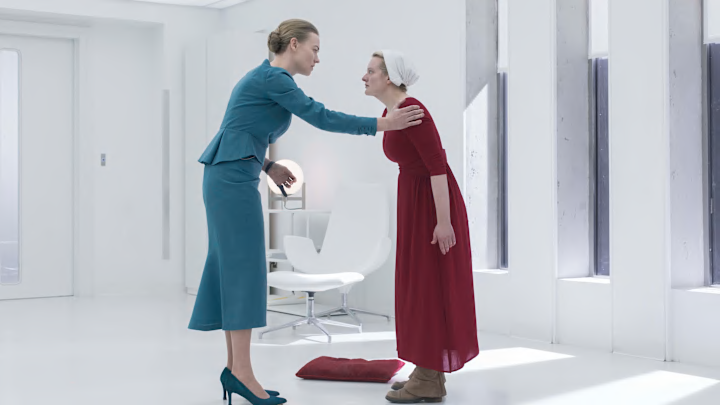In Margaret Atwood’s The Handmaid’s Tale, the dystopian world of Gilead is vividly brought to life through its rigid social hierarchy and striking visuals, particularly the use of color in costumes. Those familiar with the show can immediately tell each woman’s place in society by the color she is wearing. These colors also highlight the deeper emotional and psychological battles they face.
The symbolism of red in the handmaids’ costumes
In The Handmaid’s Tale, the color red is one of the most striking visual elements, and it’s the color of the handmaids and our main character. The handmaids’ red costumes symbolize fertility, and their job is to bear children. However, the red color also reflects violence, power, and sexuality, evoking both a sense of sin and sacrifice.
The color red also has many religious and literary references, including the scarlet letter worn by Hester Prynne, which indicates societal punishment for women who don’t follow the path. Even though Gilead’s survival depends on the handmaids, society sees them as impure.

The calm and control of teal
The wives of Gilead’s commanders wear teal, a color that represents calmness and purity. This color reflects their supposed dignity and control in the new society, but it also highlights the contrast between appearance and reality because, despite their high status, the wives remain oppressed.
Serena Joy’s journey, for example, is marked by her teal attire. As her story progresses, we see subtle color shifts in her clothing that hint at her inner turmoil.
The invisibility of Marthas: Gray and green tones
Marthas, who are responsible for household duties, wear muted shades of gray and green. These colors symbolize nature and growth and suggest their servitude to Gilead. The dull shade helps the Marthas blend into the background and remain largely invisible as they cook, clean, and take care of the household.
The choice of gray and green also signifies their duality in the dystopian society. While they are largely unseen, they are vital to the community’s operation.
The brown of the aunts: Power and suppression
The aunts in Gilead are the enforcers who ensure that the other women follow the rules. The color brown symbolizes their militaristic authority. It’s associated with grounding and practicality, reflecting their role in grounding the ideological structure of Gilead. Unlike the other women, aunts have some degree of power, especially over the handmaids, and are allowed to read and write.
The brown garments also align them with historical representations of authoritarian figures, helping enhance the dystopian reality created by the show.

What symbolism did you discover in The Handmaid’s Tale? Let us know at Hulu Watcher!
